The Legend of the Fellowship's B-Team
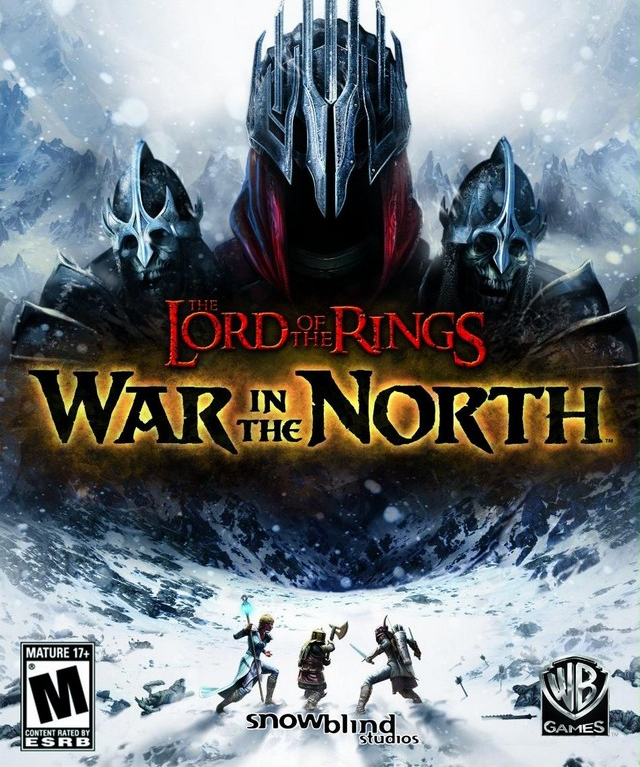
Foreword: This is my first video game review in eight, long years... Will this piece be any good?
Also, I have not tried either local or online co-op, and will review the game on the normal difficulty.
Lord of the Rings: War in the North (WITN) a tame Action RPG with little new to offer. It tells a Tolkien story that initially cannot gain separation between itself and the tribulations of the Fellowship, but has admittedly hit its stride once the playable heroes strike out on their own. Gameplay mostly consists of fighting the baddies of Middle Earth (Orcs, Uruk-hai, Trolls, spiders) with an occasionally exhilarating combat system that nonetheless lacks polish. So while I won't point to this game as a model for Action RPGs, it does just enough things competently to satisfy me.
You play as a watered-down Fellowship consisting of a Dwarf, a Man and an Elf who all happen to be close pals to Aragorn. And as all four meet up at the Prancing Pony (before Aragorn is due to intercept Frodo Baggins and his companions), the ranger sends them off to investigate some disturbances taking place at a forest north of their location. This scouting mission in turn leads to the discovery of a powerful follower of Sauron named Agandaur, who has plans to wage a bloody campaign against the peoples of northern Middle Earth. So it's up to Eradan the ranger, Farin the dwarf and Andriel the lore-master to stop the machinations of the Dark Lord's right hand man.
The game's premise has potential, but what derails the narrative experience is how the three leads are utterly devoid of personality or backstory. All three are interchangeable and share the role of the stoic, boring, do-what's-right hero that won't be fazed by the forces of darkness. They do not undergo anything resembling a character arc, and the voice acting talents of Nolan North (Eradan) and Laura Bailey (Andriel) are not enough to add any emotional depth or humanity to our heroes.
What is even more jarring is how we're given so little to work with when it comes to the trio's origins and histories prior to their operations in the north. Given the rarity of humans, dwarfs and elves working together in any capacity, a fact mentioned by other characters in the game, it is a real shame that we never got the story behind how all three met another and banded together as comrades-in-arms. All we really get is that these three are heroic patrollers working with a small team of rangers somewhere, which begs the question as to how they were stationed there in the first place. And the dearth of backstory feels even more jarring when we see this trio act as trusted allies and confidants to several name characters like Gandalf, Aragorn, Elrond, Arwen and so forth. At its worst, War in the North sounds like a sequel to a story that hasn't been written yet; and the playable three characters resemble poorly written fanfic characters with don't feel like a part of the Middle Earth universe.
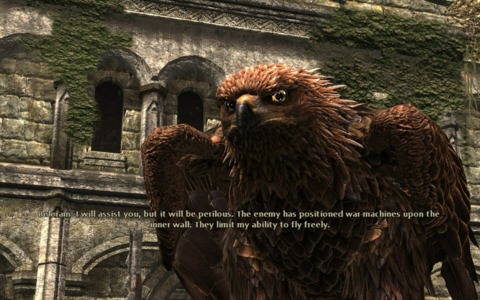
So with the leads totalling the charisma of plain bread, the onus is on the supporting cast to add some degree of stakes and flavour into Tolkien's fantasy setting. Thankfully those side-players are up to that task, starting with a Great Eagle the heroes rescue named Beleram. Not only does this character have the best voice-acting performance from John Patrick Lowrie (who gives the eagle a surprising gravitas and stateliness), but he is the closest to making a story choice ridden with consequences. As the final battle between the trio and Agandaur draws near, a gravely injured Beleram rejoins the fight despite orders from the protagonists to stay behind and recover. The actual final boss fight then presents the player with a choice to summon him against Agandaur - at the cost of the Great Eagle's life. And while the choice was very easy for me to make in the end (ie. don't use Beleram and save his life), I did feel the weight of holding a life I cared about in the balance.
Some other standouts amongst the non-playable cast include Radagast the Brown, an actual Tolkien wizard character who gets caught up in Agandaur's schemes. While Peter Jackson's Gandalf has his fair share of humorous moments laced with sarcasm, there is an airheaded-ness from Radagast that can be amusing in his limited screen time. Then there is Urgost, a ghastly dragon who Agandaur tries to recruit by threatening him with future retribution from Sauron. While this character probably took too much inspiration from Smaug, I still appreciate his badass baritone voice (provided by Trigon-playing Keith Szarabajka) and the dripping condescension he spills to the three heroes, who enter his lair with the intent of slaying him. The conversation between these two parties constitutes the game's best writing, as Urgost simultaneously plays nice with our trio while unsubtly reminding them that he can kill them at any time should they start to annoy him.
There is also a brief stay in Nordinbad, a dwarven fortress fighting off legions of orcs and Uruk-hai massing in the surrounding environs, and it's in the last third of the game where the story starts to make noticeable strides. While the resulting plot is nothing groundbreaking, I do give it credit for attempting to work as an independent story that relied less on the LOTR movie crutch to portray a relatively unexplained part of Middle Earth. So instead of feeling existential dread towards future video game interpretations of the Tolkien mythos, such concerns were downgraded to your run-of-the-mill disappointment. Given how the beginning of the story started, it could have been a whole lot worse.
Actually playing War in the North is a better experience than listening to its story, but only by so much. Structurally the game is akin to Streets of Rage - but translated into a 3D plane and a fantasy setting whilst having some RPG elements sprinkled in. Over the course of several chapters, you can pick one of the three characters to do battle with waves upon waves of orcs, undead, Uruk-hai and so on. Each hero can do a bit of everything, but they fall into the expected RPG archetypes you see in other games of the genre. Farin is the tanky dwarf who can scrap and take a lot of blows up close and personal; Andriel is the fragile cleric who can offer utility through distant magic attacks, shielding and healing; and Eradan specialises in bursts of damage when not being the enemy's centre of attention. The enemies themselves are divided into tiers, from spammable fodder, ranged archers, medium-sized fighters, to harder-hitting trolls. There are some instances when your heroes need to defend a point against enemy attack. But more often than not, the heroes are to push past several waves of enemies before making their way to the final bosses.
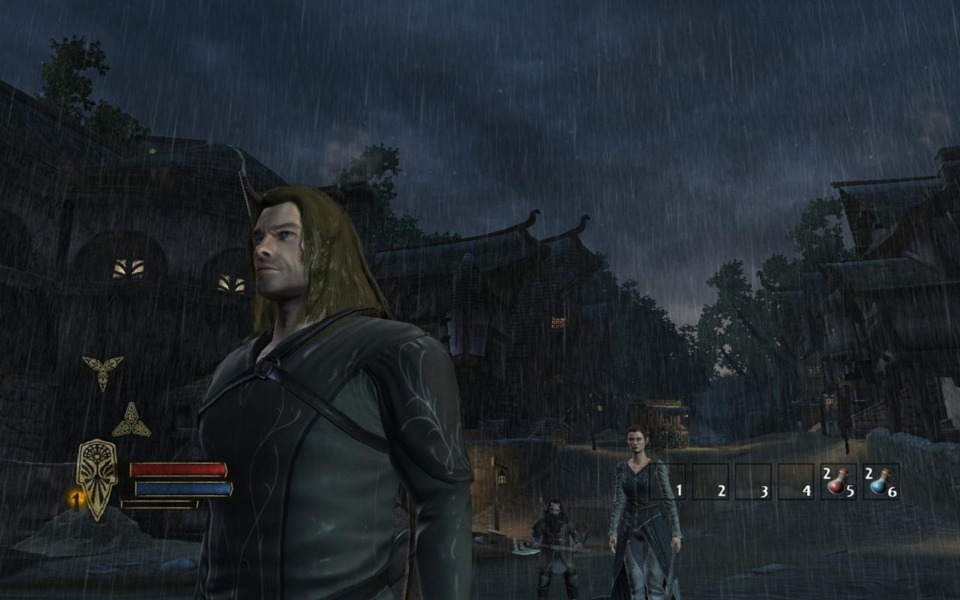
After triumphs against said bosses, our heroes will get a brief spell to buy new equipment, fix old equipment, to prepare for the next operation. The trio can also level up during the campaign to become a little stronger or durable, and spend points to learn new abilities, improve existing ones, and provide passive stat boots for certain situations (eg. increased attack power when using a bow). Additional experience points could be had by completing a plethora of unimpressive fetch quests or a series of optional battle challenges. And when combining those diversions with the main story mode, one can expect to to finish the game at around 10 or so hours.
Playing the game well requires the consistent maintenance of a character's Hero Mode. That is when Farin, Eradan or Andriel lands enough blows towards an enemy without interruption, he or she can then land a coup de grace to kill said enemy (indicated with a yellow arrow pointing down towards an enemy near death). Then for a limited time the characters' normal attacks deal more damage, which can then snowball into another finishing blow and resetting the Hero Mode timer. The game is at its best when it gets you into an effortless flow of combat where your hero dispatches one enemy which makes it easier to make mincemeat out of the other hapless foes lurking nearby. Therefore, waves with a better variety of enemies (and preferably the lighter fodder that are easy to kill off) are the most conducive to that flow experience; you can start with the minnows before working your way up to the bigger fish. On the graphics front the decapitation animations are especially brutal and visceral, doubly so when the game goes into slow-mo to highlight the execution of the last minion standing. I should also give a little credit to the sound design when the blades or hammers swing around during hero mode. The weight of the steel and iron, forged into either a blunt or sharp instrument of death, is audibly palpable as it is driven into the fleshes of Middle Earth's ne'er-do-wells. You can hear and feel the damage being done.
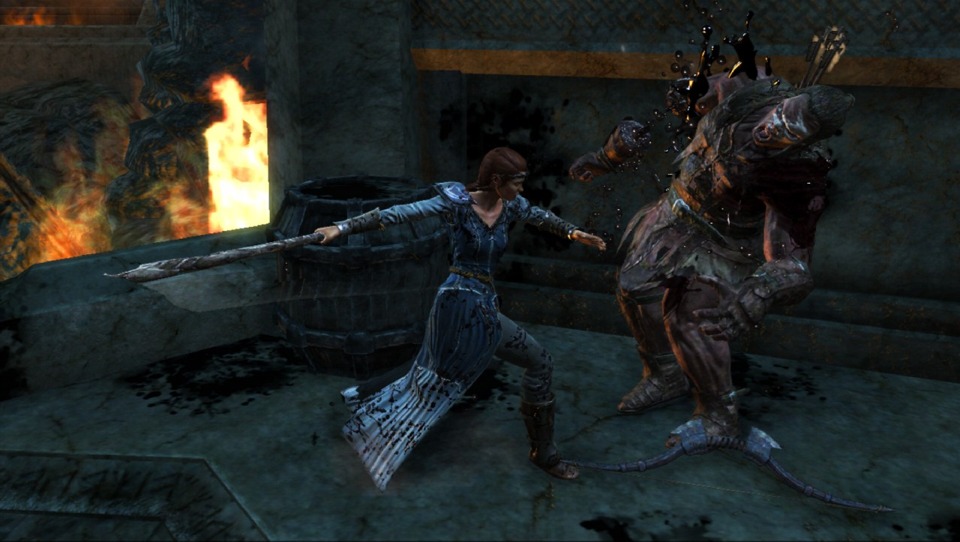
But midway through the game, the combat becomes more of a slog as enemy compositions become more homogenous by sending out the same orcs who are harder to kill without hero mode; these bastards can even block normal attacks, and even their archers can be a headache at melee range. While players can stop the bleeding by blocking attacks or dodge-rolling, these evasive manoeuvres do little to hide the fact that you're banging your fists into a brick wall. I could see the wisdom in throwing around tougher enemies, but the net effect is a less enjoyable player experience that turns fighting into a stuck-in-the-mud war of attrition (where you start chugging down the health potions that have been pretty useless up until this point). There are ways to circumvent this newer challenge, mostly through ranged combat, but I preferred the game's earlier state when it offers you the opportunity to snowball a chapter with better access and uptime for Hero Mode.
The game's hit detection can also be infuriatingly hit or miss. On one extreme is ranged combat, which has incredibly generous hitboxes that don't really require the player to aim properly; as long as the aim cursor is around the vicinity of a bad guy, the game will help you direct the projectile towards that enemy. But once players get up and close and personal the hit detection becomes spottier. Even when you think your character is directly in front of a foe, sometimes the hero will just swing at nothing but air. This lack of detail towards character targeting just feels jarring, given that the game is equally capable of blinking your hero to a vulnerable-but-out-of-blade's-reach enemy to deliver a killing blow. And the swinging and missing can be especially exasperating when your character is in Hero Mode and is pressing to attack a nearby enemy to reset that damage bonus.
The boss battles, which are supposedly the highlights of any action game, are also too repetitive. The orc captains have the worst of it, since they all share the exact attack animations from the start of the game to the near end. There is an early chapter where the heroes venture into the home turf of some cranky wights, and each of their three sub-bosses do the exact same things: throw rocks and summon undead minions. Even the more unique offerings underwhelm; hell, Agandaur himself never felt like a feared servant of Sauron once you cross swords with him. So gameplay-wise, while War in the North has its moments, I came away thinking that it could have had more polish.
The loot you find in Middle-Earth is also on the uninteresting side. Most of them are just stat sticks, and the customisation options you have to improve certain weapons and armours are limited to stat boosts, doing a little more damage, and other small buffs. The real customisation option comes from levelling up and putting points on the ability trees of each character. For example, I initially moulded Eradan into a high damage melee character for most of my playthrough. But at the very end, I then decided to respec his skill tree and turned him into a long-range specialist. These two versions of the same guy could not have played more differently, so at least I am now interested in playing around with the skill trees of the other characters if I ever get back to this game.
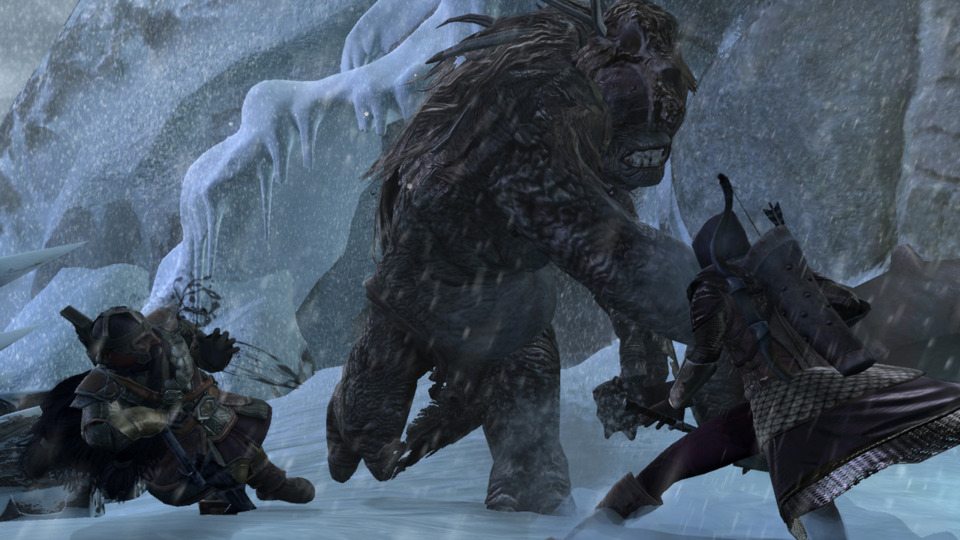
The other quibbles I have with the game are more towards some design decisions that don't derail the gaming experience per se; I just found the developers' choices to be kind of odd. Every once in a while your character (or an AI-controlled ally) falls in battle and needs to be revived by either yourself or your companions. The channel to get a character back up on his or her feet is balanced, since enemies can interrupt the process if their attacks break the revive animation. But to completely restore the revived character's health pool feels a little too much. Most revives are meant to be figurative bandaids in the heat of battle, so narratively revived characters should be around half-health after they get their second wind.
In addition, most chapters provide a midway portal that can transport you back to a hub town for the purposes of buying/selling/repairing loot. This option is obviously useful, but it really screws with the story of a few heroes thwarting the machinations of the Dark Lord; 'porting back to safe harbour while in the middle of rescuing Radagast from a Spider Queen who is about to eat him, for example, just breaks my suspension of disbelief. This sort of preparation should only be reserved between chapters, and the game already has plenty of checkpoints if all of the heroes bleed out and die. And it will throw out useful armours and weapons should your incumbents fall into disrepair in the middle of a chapter.
So putting it all together, War in the North is on the generic side when placed together with other games of its genre. It won't stand out for its ineptitude, but it also won't set itself apart with its merits. The core gameplay of fighting monsters is executed well enough, but it's missing some of the details that could make the experience truly enjoyable. The story also leans too heavily on the Lord of the Rings movie trilogy to make itself sound important, instead of establishing its stakes and consequences on its own terms. And while there are some characters who are interesting while on screen, the main three heroes that we follow throughout are severely underdeveloped and static.
Therefore, the more recent Shadow of Mordor and Shadow of War should rightfully overshadow this northern sideshow. And off the top of my head I'd also rather play the two older Battle for Middle Earth games, over WITN, to get my Tolkien fix. Still, I would consider returning to this game, if only to experiment with more character ability builds and play more Andriel (who I mostly ignored in my initial playthrough).
An easy three decapitated orcs out of five.
